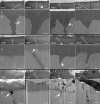Effect of dentine site on resin and cement adaptation tested using X-ray and electron microscopy to evaluate bond durability and adhesive interfaces
- PMID: 35959863
- PMCID: PMC9805029
- DOI: 10.1111/eos.12890
Effect of dentine site on resin and cement adaptation tested using X-ray and electron microscopy to evaluate bond durability and adhesive interfaces
Abstract
Glass ionomer (GI) cements and self-etch (SE) or universal adhesives after etching (ER) adapt variably with dentine. Dentine characteristics vary with depth (deep/shallow), location (central/peripheral), and microscopic site (intertubular/peritubular). To directly compare adhesion to dentine, non-destructive imaging and testing are required. Here, GI, ER, and SE adapted at different dentine depths, locations, and sites were investigated using micro-CT, xenon plasma focused ion beam scanning electron microscopy (Xe PFIB-SEM), and energy dispersive X-ray spectroscopy (EDS). Extracted molars were prepared to deep or shallow slices and treated with the three adhesives. Micro-CT was used to compare changes to air volume gaps, following thermocycling, and statistically analysed using a quantile regression model and Fisher's exact test. The three adhesives performed similarly across dentine depths and locations, yet no change or overall increases and decreases in gaps at all dentine depths and locations were measured. The Xe PFIB-SEM-milled dentine-adhesive interfaces facilitated high-resolution characterization, and element profiling revealed variations across the tooth-material interfaces. Dentine depth and location had no impact on adhesive durability, although microscopic differences were observed. Here we demonstrate how micro-CT and Xe PFIB-SEM can be used to compare variable dental materials without complex multi-stage specimen preparation to minimize artefacts.
Keywords: focused ion beam; humans; in vitro techniques; materials testing; surface properties.
© 2022 The Authors. European Journal of Oral Sciences published by John Wiley & Sons Ltd on behalf of Scandinavian Division of the International Association for Dental Research.
Conflict of interest statement
All authors declare no conflict of interest.
Figures









Similar articles
-
Bonding of universal adhesives to dentine--Old wine in new bottles?J Dent. 2015 May;43(5):525-36. doi: 10.1016/j.jdent.2015.03.004. Epub 2015 Mar 20. J Dent. 2015. PMID: 25797702
-
An in-vitro investigation of the bond strength of experimental ion-releasing dental adhesives to caries-affected dentine after 1 year of water storage.J Dent. 2022 Apr;119:104075. doi: 10.1016/j.jdent.2022.104075. Epub 2022 Feb 26. J Dent. 2022. PMID: 35227835
-
Bonding performance and ultramorphology of the resin-dentine interface of contemporary universal adhesives.Clin Oral Investig. 2022 Jun;26(6):4391-4405. doi: 10.1007/s00784-022-04402-3. Epub 2022 Feb 11. Clin Oral Investig. 2022. PMID: 35149904 Clinical Trial.
-
Physiochemical interactions at the interfaces between self-etch adhesive systems and dentine.J Dent. 2004 Sep;32(7):567-79. doi: 10.1016/j.jdent.2004.06.005. J Dent. 2004. PMID: 15386864 Clinical Trial.
-
Micro-tensile bond strengths of bonding agents to pulpal floor dentine.Int Endod J. 2002 Oct;35(10):833-9. doi: 10.1046/j.1365-2591.2002.00581.x. Int Endod J. 2002. PMID: 12406377 Clinical Trial.
Cited by
-
Effect of Contamination of Resin Composite with Latex Gloves Containing Corn Powder on Shear Bond Strength to Bovine Dentin Using Two Types of Bonding Systems.Maedica (Bucur). 2024 Sep;19(3):566-572. doi: 10.26574/maedica.2024.19.3.566. Maedica (Bucur). 2024. PMID: 39553345 Free PMC article.
-
Effect of Dentin Contamination with Hemostatic Agents and Cleaning Techniques on Bonding with Self-Adhesive Resin Cement.Med Sci Monit. 2024 Jun 3;30:e943353. doi: 10.12659/MSM.943353. Med Sci Monit. 2024. PMID: 38825814 Free PMC article.
References
-
- Chiba Y, Sunada N, Inoue N, Kawamoto R, Tonegawa M, Iwasa M, et al. Effect of operator variability on dentin bond strength of two‐step adhesive system. Adhes. Dent. 2007;25:239‐43.
-
- Perdigão J. Dentin bonding‐variables related to the clinical situation and the substrate treatment. Dent Mater 2010;26:e24‐37. - PubMed
-
- Tsujimoto A, Shimatani Y, Nojiri K, Barkmeier WW, Markham MD, Takamizawa T, et al. Influence of surface wetness on bonding effectiveness of universal adhesives in etch‐and‐rinse mode. Eur J Oral Sci 2019;127:162‐9. - PubMed
MeSH terms
Substances
LinkOut - more resources
Full Text Sources

